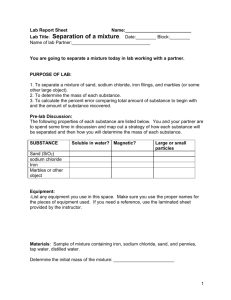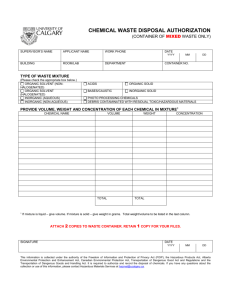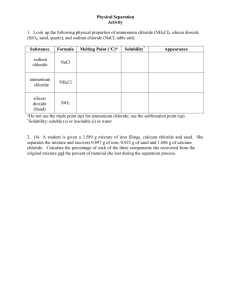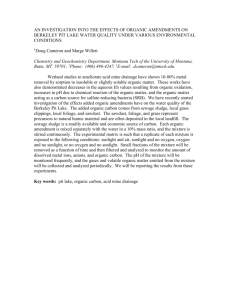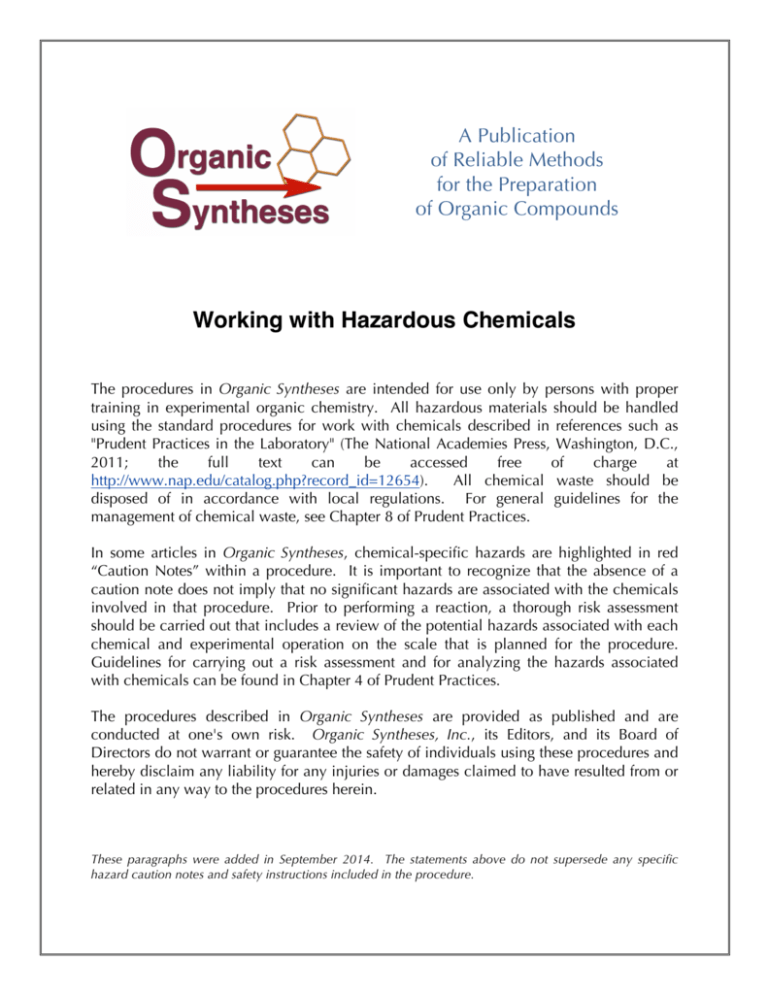
A Publication
of Reliable Methods
for the Preparation
of Organic Compounds
Working with Hazardous Chemicals
The procedures in Organic Syntheses are intended for use only by persons with proper
training in experimental organic chemistry. All hazardous materials should be handled
using the standard procedures for work with chemicals described in references such as
"Prudent Practices in the Laboratory" (The National Academies Press, Washington, D.C.,
2011;
the
full
text
can
be
accessed
free
of
charge
at
http://www.nap.edu/catalog.php?record_id=12654).
All chemical waste should be
disposed of in accordance with local regulations. For general guidelines for the
management of chemical waste, see Chapter 8 of Prudent Practices.
In some articles in Organic Syntheses, chemical-specific hazards are highlighted in red
“Caution Notes” within a procedure. It is important to recognize that the absence of a
caution note does not imply that no significant hazards are associated with the chemicals
involved in that procedure. Prior to performing a reaction, a thorough risk assessment
should be carried out that includes a review of the potential hazards associated with each
chemical and experimental operation on the scale that is planned for the procedure.
Guidelines for carrying out a risk assessment and for analyzing the hazards associated
with chemicals can be found in Chapter 4 of Prudent Practices.
The procedures described in Organic Syntheses are provided as published and are
conducted at one's own risk. Organic Syntheses, Inc., its Editors, and its Board of
Directors do not warrant or guarantee the safety of individuals using these procedures and
hereby disclaim any liability for any injuries or damages claimed to have resulted from or
related in any way to the procedures herein.
These paragraphs were added in September 2014. The statements above do not supersede any specific
hazard caution notes and safety instructions included in the procedure.
DOI:10.15227/orgsyn.062.0095
Organic Syntheses, Coll. Vol. 7, p.424 (1990); Vol. 62, p.95 (1984).
α-tert-ALKYLATION OF KETONES: 2-tertPENTYLCYCLOPENTANONE
[Cyclopentanone, 2-tert-pentyl-]
Submitted by M. T. Reetz, I. Chatziiosifidis, F. Hübner, and H. Heimbach1.
Checked by Kevin Kunnen and Carl R. Johnson.
1. Procedure
A. 1-Trimethylsiloxycyclopentene.2 A 1-L, two-necked, round-bottomed flask is equipped with a
mechanical stirrer and a reflux condenser having a drying tube (calcium chloride). The flask is charged
with 200 mL of dimethylformamide (Note 1), 45 g (0.54 mol) of cyclopentanone (Note 2), 65.5 g (0.6
mol) of chlorotrimethylsilane (Note 2), and 185 mL (1.33 mol) of triethylamine (Note 1), and the
mixture is refluxed for 17 hr (Note 3). The mixture is cooled, diluted with 350 mL of pentane, and
washed four times with 200-mL portions of cold saturated aqueous sodium hydrogen carbonate. The
aqueous phases are extracted twice with 100-mL portions of pentane and the combined organic phases
are washed rapidly with 100 mL of ice–cold aqueous 2 N HCl and immediately thereafter with a cold
saturated solution of sodium hydrogen carbonate. After the mixture has been dried over anhydrous
magnesium sulfate, the pentane is removed by rotary evaporation. Distillation of the oily residue at 60°
C (12 mm) using a 20-cm Vigreux column affords 50.1–51.6 g (60–62%) of 1trimethylsiloxycyclopentene (1) as a colorless liquid (Note 4).
B. 2-tert-Pentylcyclopentanone. A dry, 250-mL, three-necked, round-bottomed flask is fitted with a
gas inlet, a gas bubbler, rubber septum, and magnetic stirrer. The apparatus is flushed with dry nitrogen
or argon and charged with 120 mL of dry dichloromethane (Note 5), 15.6 g (0.10 mol) of 1trimethylsiloxycyclopentene and 11.7 g (0.11 mol) of 2-chloro-2-methylbutane (Note 6). The mixture is
cooled to −50°C (Note 7) and a cold (−50°C) solution of 11 mL (0.10 mol) of titanium tetrachloride
(Note 8) in 20 mL of dichloromethane is added within 2 min through the rubber septum with the aid of a
syringe. During this operation rapid stirring and cooling in maintained. Sunlight should be avoided. The
reddish-brown mixture is stirred at the given temperature for an additional 2.5 hr and is then rapidly
poured into 1 L of ice–water (Note 9). After the addition of 400 mL of dichloromethane, the mixture is
vigorously shaken in a separatory funnel; the organic phase is separated and washed twice with 400-mL
portions of water. The aqueous phase of the latter two washings is extracted with 200 mL of
dichloromethane; the organic phases are combined and dried over anhydrous sodium sulfate. The
mixture is concentrated using a rotary evaporator and the residue is distilled at 80°C (12 mm) (Note 10)
to yield 9.2–9.5 g (60–62%) (Note 11) of 2-tert-pentylcyclopentanone as a colorless oil (Note 12).
2. Notes
1. Dimethylformamide and triethylamine were purchased from Baker (Baker Analyzed Reagent) and
used without further purification.
2. Cyclopentanone and chlorotrimethylsilane were purchased from Aldrich Chemical Company and
used without further purification.
3. According to the original procedure of House,2 only 4 hr is needed, affording a 59% yield. However,
the submitters found that an increase in reaction time raises the yield.
4. The spectral properties of the compound are as follows: 1H NMR (CCl4) δ: 0.2 (s, 9 H), 1.6–2.4 (m, 6
H), 4.4 (m, 1 H); IR (film) 1645 cm−1 (lit.2 1645 cm−1).
5. Reagent-grade dichloromethane is dried by passing over a column of aluminum oxide (activity I).
6. The submitters purchased 2-chloro-2-methylbutane from Eastman Kodak Company. The checkers
prepared the halide as follows. A separatory funnel was charged with 21.5 mL (0.2 mol) of 2-methyl-2butanol and 100 mL of concentrated hydrochloric acid. The mixture was shaken vigorously with
periodic venting for 10 min. The layers were separated and the 2-chloro-2-methylbutane layer (upper)
was washed several times with equal volumes of cold water. The product was dried over calcium
chloride and distilled, bp 85°C.
7. The precise temperature is not critical. The checkers observed that the reaction proceeds in about the
same time and yield at −78°C. However, at temperatures above −40°C a drop in yield may occur.
8. The titanium tetrachloride should be clean, colorless, and free of hydrogen chloride. The checkers
used material freshly distilled in an argon atmosphere.
9. If sodium bicarbonate is used, large amounts of titanium oxide-containing emulsions tend to form that
hamper the purification of the product.
10. The by-products consist of volatile cyclopentanone and an unknown high-boiling material, so that
rapid vacuum transfer at room temperature and 0.02 mm is also possible. Extremely slow distillation at
high temperatures should be avoided. The value of 72°C (2.2 mm) cited in the literature3 seems to be in
slight error.
11. The submitters ran the reaction on a 0.5 scale and reported yields of 63–68%.
12. The product is >96% pure as checked by gas chromatography (4% UCON LB 550X, Chromasorb G,
AW-DMCS 80–100 mesh, 130°C). The spectral properties are as follows: IR (neat) cm−1: 3050–2800,
1735, 1460, 1150; 1H NMR (CCl4) δ: 0.80 (J = 6 Hz, CH3 of the ethyl group, which partially overlaps
with the signals of the other two diastereotopic methyl groups), 0.82 (s), 0.92 (s), 1.15–2.25 (m); 13C
NMR (CDCl3) δ: 7.78, 19.87, 23.72 (slightly broad), 25.57, 32.62, 34.70, 40.02, 55.39, 219.57.
3. Discussion
This procedure solves the long-pending problem of α-tert-alkylation of ketones. The generality is
shown by the fact that a wide variety of structurally different ketones can be alkylated via the
corresponding silyl enol ethers with good yields.4 Variation of the alkylating agent is also possible,
branched and cyclic tertiary alkyl halides reacting position specifically without signs of rearrangement.4
Chemoselectivity studies reveal that esters, aromatic groups, and primary alkyl halide moieties are
tolerated.4 In the case of a sensitive enol ether such as that derived from acetone, titanium tetrachloride
should be replaced by more mild Lewis acids such as zinc chloride, although the yields are lower.5
Finally, it should be noted that any SNl-reactive alkyl halide is likely to be a suitable alkylating agent in
Lewis acid-promoted α-alkylation of carbonyl compounds. Indeed, aryl-activated secondary alkyl
halides and acetates react in the same way.6 Heteroatom substituted alkyl halides and acetates also react
smoothly with enol silanes in the presence of ZnX2.4,6 Generally, such alkylating agents are unsuitable in
classical enolate chemistry because of the ease of hydrogen halide elimination and/or the failure to react
regiospecifically. The methods are thus complementary.
A related tert-butylation procedure in which the silyl enol ether is added to a mixture of titanium
tetrachloride and tert-butyl chloride gives rise to distinctly lower yields.7,8 This is also the case if the
tertiary halide is added to a mixture of silyl enol ether and titanium tetrachloride.5
A number of alternative multistep procedures for the synthesis of α-tert-alkyl ketones are known,
none of which possess wide generality. A previous synthesis of 2-tert-pentylcyclopentanone involved
reaction of N-1-cyclopentenylpyrrolidine with 3-chloro-3-methyl-1-butyne and reduction of the
resulting acetylene (overall yield 46%).3 However, all other enamines tested afford much lower yields.3
Cuprate addition to unsaturated ketones may be useful in certain cases.9 Other indirect methods have
been briefly reviewed.5
References and Notes
1.
2.
3.
4.
5.
6.
7.
8.
9.
Fachbereich Chemie der Universität, Hans-Meerwein-Strasse, 3550 Marburg, West Germany.
House, H. O.; Czuba, L. J.; Gall, M.; Olmstead, H. D. J. Org. Chem. 1969, 34, 2324.
Hennion, G. F.; Quinn, F. X. J. Org. Chem. 1970, 35, 3054.
Reetz, M. T.; Maier, W. F. Angew. Chem., Int. Ed. Engl. 1978, 17, 48; review: Reetz, M. T.
Angew. Chem. Int. Ed. Engl. 1982, 21, 96,
Reetz, M. T.; Maier, W. F.; Heimbach, H.; Giannis, A.; Anastassiou, G. Chem. Ber. 1980, 113,
3734.
Reetz, M. T.; Hüttenhain, S.; Walz, P.; Löwe, U. Tetrahedron Lett. 1979, 4971; Paterson, I.
Tetrahedron Lett. 1979, 1519; Reetz, M. T.; Schwellnus, K.; Hübner, F.; Massa, W.; Schmidt, R.
E. Chem. Ber. 1983, 116, 3708.
Chan, T. H.; Paterson, I.; Pinsonnault, J. Tetrahedron Lett. 1977, 4183.
Maier, W. F. Dissertation, Universität Marburg, 1978.
Posner, G. H. Org. React. 1972, 19, 1; Corey, E. J.; Chen, R. H. K. Tetrahedron Lett. 1973, 1611.
Appendix
Chemical Abstracts Nomenclature (Collective Index Number);
(Registry Number)
calcium chloride (10043-52-4)
acetylene (74-86-2)
hydrogen chloride,
hydrochloric acid,
HCl (7647-01-0)
sodium bicarbonate,
sodium hydrogen carbonate (144-55-8)
sodium sulfate (7757-82-6)
nitrogen (7727-37-9)
acetone (67-64-1)
zinc chloride (7646-85-7)
tert-Butyl chloride (507-20-0)
Cyclopentanone (120-92-3)
Pentane (109-66-0)
dichloromethane (75-09-2)
magnesium sulfate (7487-88-9)
2-Methyl-2-butanol (75-85-4)
dimethylformamide (68-12-2)
titanium tetrachloride (7550-45-0)
triethylamine (121-44-8)
argon (7440-37-1)
2-chloro-2-methylbutane (594-36-5)
CHLOROTRIMETHYLSILANE (75-77-4)
1-Trimethylsiloxycyclopentene (19980-43-9)
2-tert-Pentylcyclopentanone,
Cyclopentanone, 2-tert-pentyl- (25184-25-2)
N-1-cyclopentenylpyrrolidine
3-chloro-3-methyl-1-butyne (1111-97-3)
Copyright © 1921-2005, Organic Syntheses, Inc. All Rights Reserved

